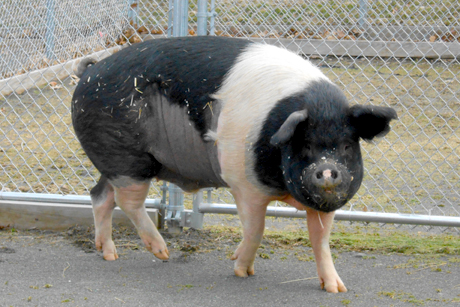Hampshire pig gets pioneering cancer treatment
By Carly Hodes

Playful as a puppy even at 730 pounds, Nemo, a rescued black-and-white Hampshire pig, became a porcine pioneer when lymphoma struck.
Undergoing a novel care plan, he became a teaching case for veterinary oncologists at the Cornell University Hospital for Animals (CUHA), paving the way to combat cancer in large animals.
Nemo is believed to be the first pig to be treated for lymphoma. The pig’s medical treatment began when his owner, George Goldner, saw his friend fall ill.
“I want to do everything humanly possible for my animals,” said Goldner, who has a farm sanctuary in New York’s Catskill Mountains. “They’re rescues, and we [with co-owner Nancy Krieg] keep them for life. Pigs are very smart. If you’re nice to them they’re very friendly. Nemo’s a real performer; he’s attractive, loves people and has a great personality.”
When the 4-year-old had a coughing fit and laid down in the snow, Goldner drove Nemo nearly four hours to Cornell’s hospital, where the pig was diagnosed with presumptive B-cell lymphoma, a blood cancer.
CUHA clinicians from across fields worked to prepare for intravenous medication delivery. In the first such procedure ever done to treat a sick pig, surgeon Jim Flanders, who had performed similar procedures in smaller animals, joined large-animal surgeon Susan Fubini to surgically implant a vascular access port.
They ran a catheter up a vein in Nemo’s neck to a port behind his ear, creating a route for delivering drugs where they would be most effective while minimizing harm. Resident Emily Barrell selected and delivered the chemotherapeutic drugs.
“Although lymphoma has been documented in swine, there aren’t any documented cases of pigs being treated for it,” said CUHA oncologist Cheryl Balkman. “We adapted a treatment plan based on what we know is effective in dogs, cats and humans with lymphoma.”
Nemo’s clinical signs soon resolved, and he has continued to do well during long-term treatment. Though little is known about the prognosis for pigs with cancer, Nemo has the notable distinction of establishing a precedent for pigs battling cancer, giving veterinarians valuable information for helping large animals. Since arriving in March, Nemo has resided at CUHA.
“He has a better life there,” said Goldner. “He’s running around digging holes, eating pineapples, communicating vocally and getting lots of love. CUHA’s people play with him and bring him treats, and he plays funny tricks like tossing water at the residents. The vets have cared for him with amazing dedication and thoughtfulness, especially Dr. Barrell. It’s been a wonderful effort on the part of several people: a testament to the outstanding work done at Cornell.”
Carly Hodes ’10, MBA ’15, is a communications specialist at the College of Veterinary Medicine.
Media Contact
Get Cornell news delivered right to your inbox.
Subscribe